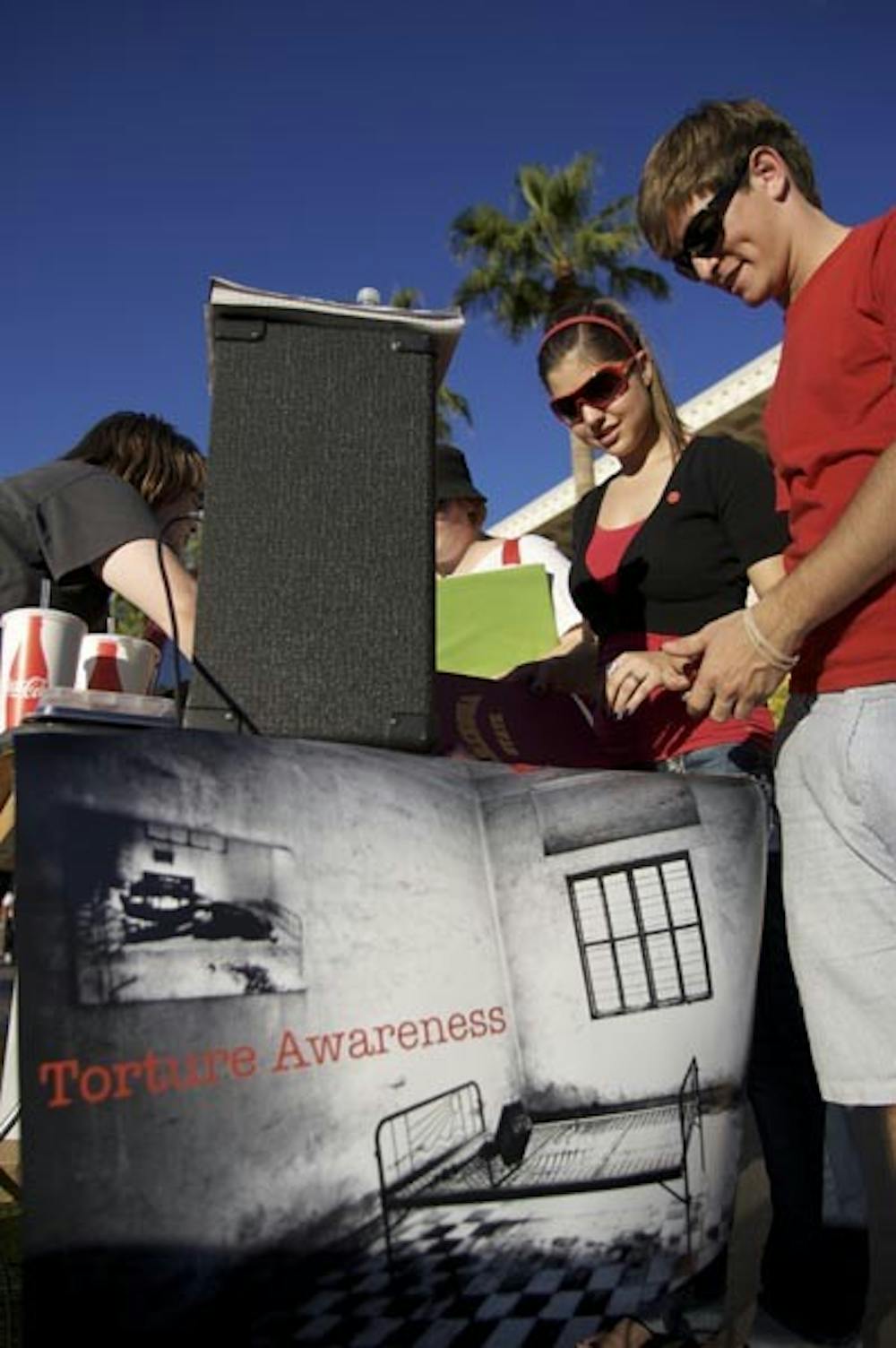Disturbing sounds of screams and cries echoed through Hayden Lawn Tuesday afternoon.
Part of a campaign to spread torture awareness on campus, a few students from a human rights and democracy course organized a class project titled “The Sound of Torture” to solicit students about the many tactics of torture utilized around the world.
The campaigners displayed posters showing images of torture tactics, while self-made sounds of screaming played over an audio system. Passing students were asked if they were interested in hearing about methods of torture.
The students aimed to organize a campaign to promote awareness of an issue regarding human rights.
Eric Kuster, political science senior and a member of the campaign project, said he typically is not interested in solicitors on campus.
“I’m usually the person with my headphones in unless I see something that really entices me,” Kuster said.
The purpose of the campaign is to grab the attention of the people walking around in order to provide an educational standpoint about torture around the world, he said.
Most people are not interested in hearing about torture, but every once in a while there are some enthusiastic people about the subject, said Jon Freshour, justice studies sophomore and a member of the campaign project.
The issue is that a lot of people do not recognize the prevalence of torture in their daily lives, he said. However, there were some extreme cases in which people expressed a lot of anger toward the idea during the campaign.
Freshour said an older man spit on one of the campaigner’s feet when she asked him if he wanted to hear about torture.
“It’s a sensitive subject,” Freshour said.
Many people assume that when others speak about torture, they are referring to other countries and not the U.S., he said.
The U.S. is a member of the United Nations, which condemns torture, but this country has been identified as practicing a form of torture known as waterboarding, which is a simulation of drowning, Freshmour said. Most countries participate in different forms of torture, whether legally or illegally, but oftentimes not openly.
In his first month in office, President Barack Obama signed an executive order banning the use of harsh interrogation techniques.
However, in countries like China, awkward stress positions are highly used, and many forms of torture have religious ties to their reason for use, which promotes continued humiliation and degradation of torture victims, said Sarah Burke, conservation biology and ecology freshman and member of the campaign project.
Other places in the world, like Africa, use other means of torture, like child soldiers or sex trafficking, Burke said.
Math junior Kevin Ashley said torture is inappropriate, but feels students may be less opposed to the idea in the extreme case to prevent crimes of mass populations, at least in the U.S
“Torture is a practice that needs to stop in any truly civilized nation,” Ashley said.
Film sophomore Madison Lipari said torture is not efficient.
“I just think there are better ways to condemn people,” Lipari said.
There are actually people who do believe torture is needed, said Marcus Mateus, arts sophomore and project campaigner.
“I don’t think people realize that everyone is entitled to their human rights,” Mateus said. “Torture is still apparent in today’s world, and human rights are continually being threatened.”
The first step of resolving the problem is recognizing that the problem does exist, Burke said.
By showing students pictures of wounds and deformations resulting from torture tactics, students get an idea of torture’s reality and its occurrence around the world, she said.
To promote awareness, students were then asked to include their fingerprints on a poster that displays the geographical representation of the world’s countries in order to represent their voice in the human rights struggle.
This idea was meant to make the torture awareness campaign more personal and relative to students, Burke said.
“You leave a piece of yourself behind and have a mark on your finger, which is a personal reminder of what you learned about torture,” Burke said. “This is meant to make students feel more connected with victims of torture who are eternally marked by torture and its effects.”
“The Sound of Torture” campaign will be continuing on Hayden Lawn Thursday from 1:30 p.m. to 4:30 p.m.
Reach the reporter at asjohn10@asu.edu





